-
1 of 253523 objects
Bust of an enslaved man c. 1700
Marble, limestone | 100.0 x 62.0 x 44.0 cm (whole object) | RCIN 1396
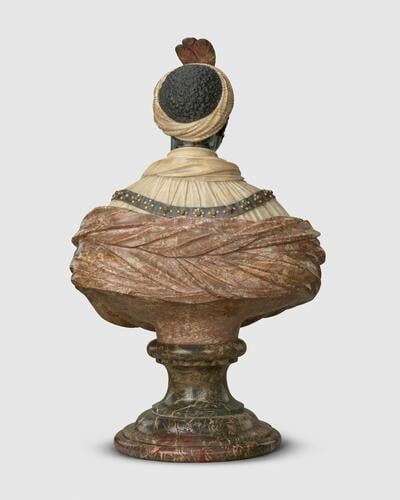
John van Nost (fl.1692 - d.1710)
Bust of an enslaved man c. 1700
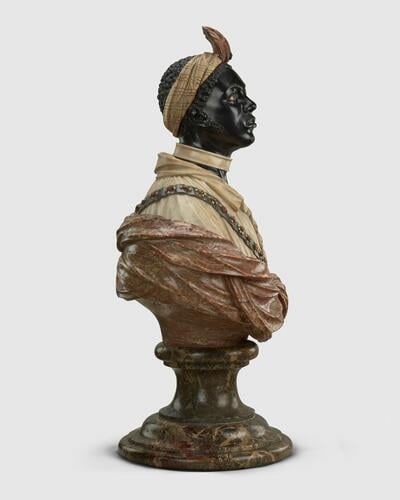
John van Nost (fl.1692 - d.1710)
Bust of an enslaved man c. 1700
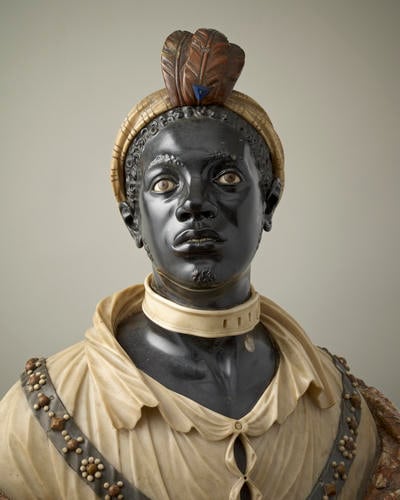
John van Nost (fl.1692 - d.1710)
Bust of an enslaved man c. 1700
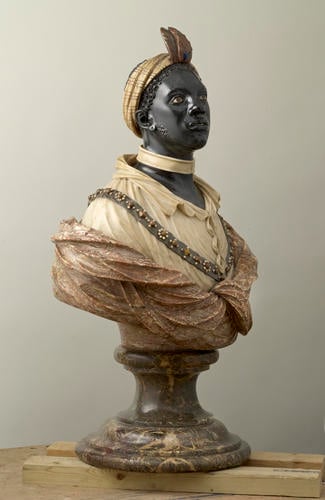
John van Nost (fl.1692 - d.1710)
Bust of an enslaved man c. 1700
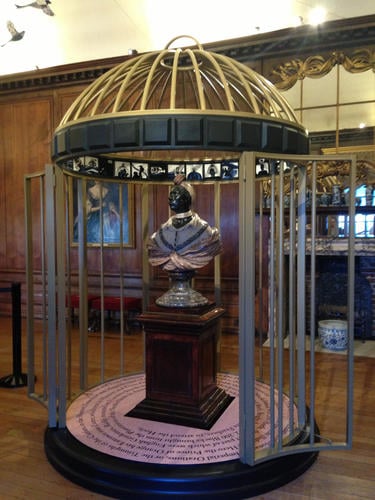
John van Nost (fl.1692 - d.1710)
Bust of an enslaved man c. 1700






-
A life-size composite marble bust of an enslaved man, his head turned and looking up to the left; short hair, small beard to chin, wearing a headband with three feather plumes applied with a triangular lapis lazuli jewel to the front, collar about his neck with several adjusting holes, a shirt buttoned at the neck (the buttons now missing) with a jewelled collar and wrap tied about; resting on a waisted turned marble socle, the person and clothing represented by different coloured marble in comesso technique. The head is joined to the shirt, and the collar and chain applied separately.
The work is a rare example by Nost of a hardstone mosaic technique commesso di peitre dura. van Nost, from Mechelen, was first recorded working as a stone mason at Windsor in 1679. His workshop was known for lead garden statuary figures, marble chimneypieces and memorials, as well as coloured marbles. In 1704 Queen Anne paid £80 for a table slab of coloured marble for Kensington palace and the catalogue of a sale of his stock in trade in 1712 includes numerous coloured marbles in the form of tables, basins and chimneypieces (Burlington Magazine, 1987). Nost made very few busts outside funerary monuments, and none incorporating coloured marbles. The initials J.N. correspond to those found on his documented works, as does the 'Fecit'. The symmetrical drapes are not typical.
Composite busts were found in antiquity and revived in sixteenth- and seventeenth-century Italy. Most commonly the head is either solid marble or hollow bronze and the bust composed of thin veneers to the stone core. Here, the marble seems to have been worked in greater thicknesses. The black head and neck is polished limestone, perhaps from the Low Countries. The pink mottled drapes and the greenish socle are of a kind known as africano in Italy and may have seemed particularly appropriate to the subject.
In comparison with seventeenth-century busts of this kind, including works by Cordier and busts described as 'Ethiopians' in the collection of Charles II of Spain, the approach to drapery here sets it apart.
The bust has been described as a portrait of a favourite servant of William III (Ernest Law, 1913), but there is no contemporary record of his identity. Although the jewelled headband and collar suggest high rank (and an 1831 guidebook to Kensington Palace suggested the sitter was an African prince), the dog-collar around his neck is unmistakably that of an enslaved person. Two small stubs of marble may indicated that it formerly had a clasp or padlock. The sculpture was previously referred to as 'Bust of a Moor', a title likely taken from London in 1710 from the Travels of Zacharias Conrad von Uffenbach (trans. and ed. W.H. Quarrell and M. Mare, London, 1934), which described a 'bust of a Moor very well done from life – made, indeed, of nothing but coloured stones, with great skill' at Kensington Palace. Accounts of London in the early eighteenth century speak of a large Black population employed as servants, footmen, coachmen and musicians, as well as serving in the military, but enslaved people were also evidently still regarded as personal property (Tatler, 31 October - 2 November 1710 and Dabydeen, 1987).
Text adapted from Sculpture in the Collection of His Majesty The King (2025).
[on pedestal RCIN 1389]Provenance
Probably at Kensington Palace by 1710; may have been commissioned by William III.
Loaned to the Manchester Art Treasures exhibition, 1857.
In 2013-14 the bust was the centrepiece of an installation by Grahame Mortimer Evelyn entitled Call and Responses: the Odyssey of the Moor commissioned by Royal Collection Trust and Historic Royal Palaces, in the State Apartments at Kensington Palace. -
Creator(s)
-
Medium and techniques
Marble, limestone
Measurements
100.0 x 62.0 x 44.0 cm (whole object)
40.0 cm (Width) (diameter)
Category
Object type(s)
Alternative title(s)
[Historic title] Bust of a Moor
Place of Production
England